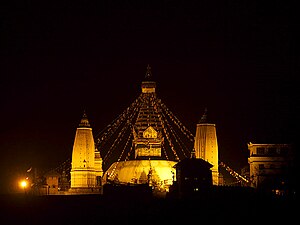Swayambhunath

| Part of a series on |
| Buddhism |
|---|
 |
Swayambhunath (Devnagari: स्वयम्भूनाथ स्तुप, English (rarely):Monkey Temple) along with the huge Boudhanath stupa to the east, is one of the most ancient and holiest Buddhist sites in the Kathmandu. It sits on a hill in the west of Kathmandu overlooking the city.
Mythology
According to Swayambhu Purana, the entire valley was once filled with an enormous lake, out of which grew a lotus. The valley came to be known as Swayambhu, meaning "Self-Created." The name comes from and eternal self-existent flame (svyaṃbhu) over which a sūpa was later built.[1]
The Bodhisatva Manjushri had a vision of the lotus at Swayambhu and traveled there to worship it. Seeing that the valley can be good settlement and to make the site more accessible to human pilgrims, Manjushri cut a gorge at Chovar. The water drained out of the lake, leaving the valley in which Kathmandu now lies. The lotus was transformed into a hill and the flower become the Swayambhunath stupa.
History
Swayambhunath, is among the oldest religious sites in Nepal. According to the Gopālarājavaṃśāvalī Swayambhunath was founded by the great-grandfather of King Mānadeva (464-505 CE), King Vṛsadeva, about the beginning of the 5th century CE. This seems to be confirmed by a damaged stone inscription found at the site.[2] The history of the site itself apparently dates back to long before the arrival of Buddhism in the Kathmandu valley.
Although the site is considered Buddhist, the place is revered by both Buddhists and Hindus. Numerous Hindu kings are known to have paid their homage to the temple including the most powerful king of Kantipur- Pratap Malla.

Architecture
The stupa consists of a dome at the base. Above the dome, there is a cubical structure present with eyes of Buddha looking in all four directions. There are pentagonal Toran present above each of the four sides with statues engraved in them. Behind and above the torana there are thirteen tiers. Above all the tiers, there is a small space above which the Gajur is present.
Symbolism
The dome at the base represents the entire world. When a person awakes (represented by eyes of wisdom and compassion) from the bonds of the world, the person reaches the state a bit higher. The thirteen pinacles on the top of it symbolises that sensient beings have to go through the thirteen stages of enlightenment to reach Buddhahood.
On each of the four sides of the main stupa there are a pair of big eyes which represent Wisdom and Compassion. Above each pair of eyes is another eye, the third eye. Saying goes that when Buddha preaches, cosmic rays emanate from the third eye which acts as message to heavenly beings, so that those interested can come down to earth to listen to the Buddha. The hellish beings and beings below the human realm cannot come to earth to listen to the Buddha's teaching, however, the cosmic ray relieves their suffering when Buddha preaches.
There are carving of Panch Buddhas (five Buddhas) on each of the four sides of stupa. Apart from this, idols of the Buddhas are at the base of the stupas. Panch Buddhas are Buddha in metaforical sense in Tantrayana. They are Vairochana (occupies the center and is the master of the temple), Akshobhya (faces the east and represents the cosmic element of consciousness), Ratna Sambhava (faces the south and represents the cosmic element of sensation), Amitabha (He represents cosmic element of Sanjna (name) and always faces the West) and Amoghsiddhi (He represents the cosmic element of conformation and faces the north).
Each morning before dawn, hundreds of pilgrims ascend the 365 steps from eastern side that lead up the hill, passing the gilded Vajra (Tibetan: Dorje) and two lions guarding the entrance, and begin a series of clockwise circumambulations of the stupa.
Gallery
-
Swayambhunath
-
Shikhar style temple erected by king Pratap Malla
-
Pigeons on the white dome
-
Circular cloud above the white stupa
-
Pilgrims descending the 365 steps leading to the stupa
-
Sadhu with 27 year old dreadlocks
-
Hindu girls spinning the prayer wheels
-
View on Kathmandu from the Swaymbhunath hill
-
Many monkeys can be found surrounding this stupa
-
Stupa at Swayambhunath
-
Buddhist gompa, Swayambhunath
-
The hillock of Swayambhunath
Footnotes
References
- Swoyambu Historical Pictorial. Edited by Richard Josephon. (1985). Satya Ho. Kathmandu.
- Psycho-cosmic Symbolism of the Buddhist Stūpa. Lama Anagarika Govinda. (1976) Dharma Books. Berkeley, California. ISBN 0-913546-35-6; ISBN 0-913546-36-4 (pbk).
Further reading
- Ehrhard, Franz-Karl (1989). "A Renovation of Svayambhunath-Stupa in the 18th Century and its History (according to Tibetan sources)." Ancient Nepal - Journal of the Department of Archaeology, Number 114, October-November 1989, pp. 1-8.




